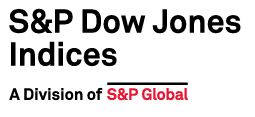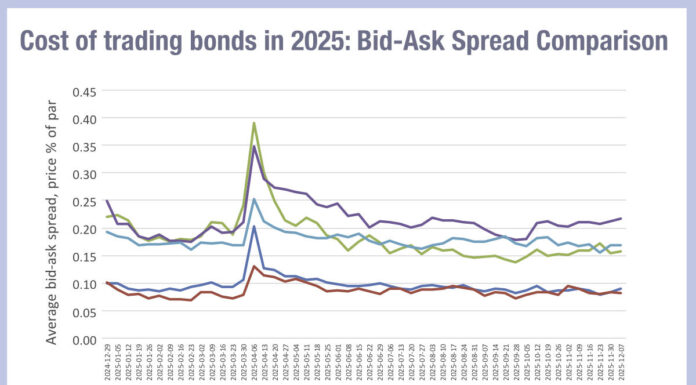In Latin American (LatAm) markets, economic volatility may transfer into market volatility – most notably in Mexico.
In order to manage risk and seize opportunities as directional moves occur, access to anonymous trading, pre-trade data and a range of trading protocols could materially affect execution outcomes.

Maria Calderon, head of LatAm sales at market operator MarketAxess, says, “The investor can rely on e-trading to trade quickly at the best levels, so both transitional and committed investors are seeing that this is the best way of obtaining that ‘in-the-moment’ liquidity.”
Fitch’s recent note on the region flagged that the regional outlook is broadly ‘neutral’, implying that two-way directional flows are likely to be sustained for the rest of 2025, creating strong natural liquidity, yet potentially with tempered volume ahead of any news event due to the relative risks of LatAm debt versus other markets.
Latin American sovereign hard currency issuance totalled US$38.6 billion in the first half of 2025, representing nearly the entirety of debt issued in 2024 and an increase of 54% on the same period last year. As new issuance correlates with additional liquidity, this will have been significantly supportive for traders.
Mexico has seen a good share of that issuance, issuing US$12 billion of debt in July 2025 to support Petroleos Mexicanos (Pemex), two billion more than planned, thanks to oversized investor appetite.
Trading Mexico
Yet traders will need to navigate volatility to a greater degree in Mexico due to several unique dynamics. US policy is directly targeting Mexico and its economy. The trade war is impacting Mexican industry, although it has escaped the worst of US import taxes levied on other markets.
“Mexico remains notably vulnerable to a trade war with the US that will continue to pressure business and consumer confidence and economic growth, affecting bank and non-bank financial institutions (NBFIs), corporates, and asset-backed security (ABS) structures,” writes Fitch Ratings.
“Other countries will also face significantly higher tariffs but with less direct effect. The indirect feedthroughs from slowing global growth, notably in key commodity importers such as the US and China, could be more impactful for the region beyond Mexico.”
US policy on migrants from Mexico is also hitting the flow of capital into the country. Average monthly remittances into Mexico are down between 7-15% year-on-year, having peaked at US$6 billion a month, according to Morgan Stanley data, and one of the bank’s analysts recently noted this could amount to ~0.5% of GDP.
On the upside, unemployment in Mexico is at a record low. Local buy-side liquidity is improving. A change was made to guaranteed monthly pension payments after the 2024 election via accounts managed by privately-run retirement fund administrators, who will now replace 55% of pre-retirement pay, up from 15%. This additional money will reduce consumer spend, but will increase investible assets under management (AUM) via local buy-side capacity for debt and therefore natural liquidity.
With ‘pen risk’ – a sudden US policy shift – able to alter dynamics at any moment, buy-side traders need to assess how they maximise access and minimise signalling.
Drivers of value in LatAm and impact of trading
For bond traders, understanding how access to liquidity can be optimised will be critical. Sources indicate that electronic trading might currently make up around 30% of trading in hard currency LatAm debt, but that figure is growing.

Michael Baptista, head of EM dealer sales, LatAm at MarketAxess says that local currency debt is often traded using the request for market (RFM) protocol, which allows dealers to provide a two-way price to clients.
“The liquidity picture is quite robust,” he comments. “The bid-offer spreads on those trades are typically extremely tight and can be inverted compared to those outside the system. With the growth of the pension funds in the market as a whole, the liquidity picture is only going to improve.”
The two-way price helps market makers to avoid having their positions known by other traders if they take a client’s order.
“It helps winning dealers work out of a risk position,” he says. “It reduces the information leakage and from the client side, their direction is masked. So both sides really like it, they’re more comfortable trading larger size as a result and it’s led to a growth in block trading for sure.”
Hard currency debt is more commonly traded via the request for quote (RFQ) protocol, in which several liquidity providers are asked for a directional price.
“Within that, Open Trading (all-to-all) has up to a 50% penetration rate across for LatAm and Mexican assets in hard currency,” says Calderon. “Investors get exceptional liquidity whether it is via Open Trading or direct-to-known-dealer counterparties.”
She also notes that trade sizes have been increasing across both RFQ and all-to-all trading more specifically.
“We have seen a 47% increase in LatAm block sizes year to date and have now developed targeted high-touch trading for even larger trades, as investors have become comfortable trading size on the system,” she says.
As their portfolio managers assess the pros and cons of positions in Mexican debt, buy-side traders will need to carefully consider whether they have the right execution paths to express investment ideas into the market with the right level of speed, price transparency and anonymity under stressed conditions to best protect their end investors.
©Markets Media Europe 2025

















